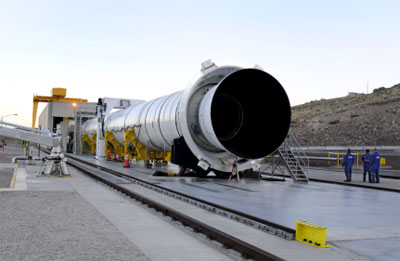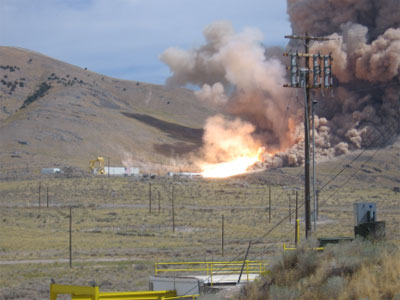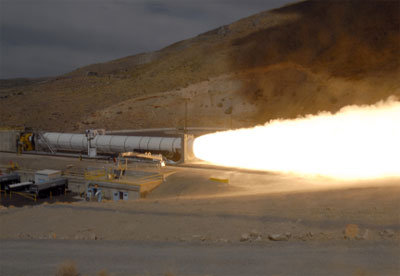Taming the fire: the Ares 1 first stage development testby John M. Jurist
|
 Preparing the DM-1 motor for its test firing. (credit: ATK) |
An interesting bit of legacy with the DM-1 test article is the fact that the case components are recycled. Collectively, the components were previously used in five static tests of the boosters for the shuttle and in 48 shuttle flights. That goes from to the stiffener above the aft dome, which was flown on STS-1, to the forward dome and other components flown on STS-118.
| It is, in model rocket terminology, five letters beyond, or 25 or 64 times as large as, the impulse of a Z motor. In other words, it is really, really big. |
At 1 pm, the countdown reached zero. The igniter squibs lit and ignited 134 pounds (60 kilograms) of a special hot-burning propellant formulation. The resulting fireball and pressure wave traveled 142 feet (43.2 meters) down the propellant bore to the nozzle inlet at a speed of about 370 mph (595 km/h) leaving burning rocket propellant in its wake. The fireball accelerated to sonic velocity in the nozzle throat and a shockwave erupted that could be visibly traced by an expanding arc of disturbed weeds around the test site. The shockwave was closely followed by the fireball as it blasted through the mirror set up behind the nozzle to allow high-speed video recording of the fireball progressing down the bore. The motor came up to a thrust to weight ratio exceeding one within 260 milliseconds and full nominal thrust within one second of squib activation.
The exhaust plume entrained air with it and converted the sand covering protecting the concrete surface of the test area into blobs of molten silica that were scattered out over the gully behind the nozzle. As the motor attained nominal thrust, it pushed against a load distribution and monitoring truss and up against a concrete thrust block designed to withstand more than 4,300,000 pounds (19.1 million newtons) of side force without tipping over. The thrust block is shaped like an inverted rectangular mushroom. The underground portion measures 40 by 80 by 100 feet (12.2 by 24.4 by 30.5 meters) and the above ground portion is about half that size. It contains 8,000 cubic yards (6,100 cubic meters) of concrete and weighs 12,000 tons. At nine cubic yards per cement truck, imagine this block as almost 900 truckloads of concrete. Everything about this test was big—including the price tag of more than $75,000,000.
Technicians, computers, and data recorders absorbed about 650 channels of data for analysis and monitoring of the motor’s performance and evaluation of 46 design objectives. The thrust vectoring system, or TVS, was exercised in two planes as part of the test protocol. This aspect of the test was of special interest since a fault warning in the TVS auxiliary power unit test panel caused the scheduled test on August 27th to be held and then scrubbed at minus 20 seconds.
 Another view of DM-1. Part of the thrust block can be seen at the extreme right. (credit: ATK) |
I watched all this from about 1½ miles (2.4 kilometers) away in relative silence for several seconds. Then the airborne sound arrived at my site. It was loud. The noise was the proximate cause of my flashback to that painting in my waiting room and to that July day when Apollo 11 launched. It was felt as much as heard, and it continued for 123 seconds until the propellant was exhausted except for a few burning slivers. At this point, cooling water was sprayed onto the motor, and cold carbon dioxide gas was injected into both the head and up into the nozzle to minimize residual burning of the motor insulation and allow later examination and analysis of the insulation.
The crew of Apollo 11 may have been riding the fire four decades ago, but ATK was taming the fire for future use right now. This monster is intended to carry an upper stage and crewed capsule totaling 415,400 pounds (188,400 kilograms) up to 188,500 feet (57.5 kilometers) and Mach 5.7 and 46 miles (74 kilometers) downrange before burning out and parachuting into the ocean for recovery and reuse.
The Ares program has been controversial, but my three prior visits to ATK’s Promontory site with explicit invitations to question the engineering team without limitation has convinced me of the competence of the Ares 1 first stage development team and has addressed all of my technical concerns—especially those related to crew safety.
| Early in my career, I was asked several times if I would ride a Saturn 5. Being young and naïve, I always said I would. If I were to be asked the same question about Ares 1, the answer would be not only yes, but hell yes. |
Review of the crew survival analysis performed by the US Air Force in the event of a motor failure clearly shows, in my opinion, a number of fatal analytical flaws that would not pass even the most cursory scientific and technical review (see “Ares 1 launch abort: technical analysis and policy implications”, The Space Review, August 17, 2009). I am convinced that the Ares 1 program has been getting a bum rap in the media on technical grounds. Interestingly, a Florida newspaper recently printed an article on the Air Force crew survival analysis, and, when provided with a rebuttal response, refused to print it. It is not surprising that the public is so ill-informed about technical issues when agenda-driven media selectively filter news reporting.
We can all argue whether or not Ares 1 is optimally elegant or even cost-effective, but it is in an advanced state of development. Compared with many other government programs, I believe it merits pursuing.
 A view of DM-1 from 1½ miles away. |
The expressions, comments, and body language of the engineers, technicians, and management at the test site all indicated great pride in what they have accomplished and the potential it represented for future human spaceflight. I didn’t see anybody looking casual or blasé about the Ares 1. The VIP viewing area was crowded with off-duty ATK employees who came over to watch the test. The public viewing area held an estimated crowd of 10,000 people who came out to an incredibly remote area on a hot late summer day to watch. I strongly recommend that all space advocates view a static test or a launch of a large rocket in order to gain an appreciation for the effort and knowledge base involved.
Early in my career, I was asked several times if I would ride a Saturn 5. Being young and naïve, I always said I would. Later, when asked the same question about the shuttle, I would answer possibly but reluctantly, and only if there was a very clear and compelling reason to do so. If I were to be asked the same question about Ares 1, the answer would be not only yes, but hell yes. Unfortunately, the only feasible way for me to get into space and to the Moon is in an urn, but I fervently hope the human race can do so firsthand and soon. Ares offers a relatively rapid way to do so. The alternative of scrapping the program and starting with another architecture will just lead to more delays and an increased risk of accomplishing nothing at all.
